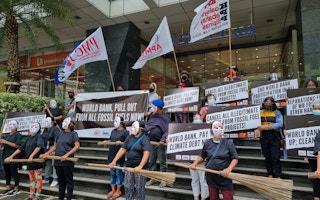The Asian Development Bank (ADB) will expand its climate financing goals by US$20 billion to a new target of US$100 billion over the period of 2019 to 2030, the multilateral bank’s chief said on Wednesday.
To continue reading, subscribe to Eco‑Business.
There's something for everyone. We offer a range of subscription plans.
- Access our stories and receive our Insights Weekly newsletter with the free EB Member plan.
- Unlock unlimited access to our content and archive with EB Circle.
- Publish your content with EB Premium.
“The battle against climate change will be won or lost in Asia and the Pacific,” said Masatsugu Asakawa, president of ADB. “The climate crisis is worsening daily, prompting many to call for increased climate finance. We are taking action to meet this call by elevating our ambition to US$100 billion in cumulative climate finance from our own resources by 2030.”
But United Nations secretary-general Antonio Guterres reiterated that US$100 billion a year from public and private sources is the “bare minimum” that will be needed for climate mitigation and adaptation for the developing world.
“Much more will be needed and development banks have an essential role to play. We need you to spearhead the transition of energy systems from fossil fuels to renewables, while also ensuring universal access to energy. You must lead the way in supporting credible, just transition plans,” Guterres said in a recording posted in his Twitter account today.
“
The battle against climate change will be won or lost in Asia and the Pacific.
Masatsugu Asakawa, president, Asian Development Bank
In 2018, ADB committed to ensuring at least 75 per cent of its operations support climate action and its own climate finance resources reach at least US$80 billion by 2030. The development bank expects funding from its own resources in 2019 to 2021 to reach about US$17 billion.
Shortfall in the delivery of climate finance is one of the biggest challenges for parties at the 26th UN Climate Change Conference (COP26) happening in Glasgow next month.
Developed country governments made a pledge in 2009 for US$100 billion a year in climate finance by 2020, but have fallen well short of that target. Climate finance reached only US$80 billion in 2019 and observers say the US$100 billion goal is likely to be missed amid the economic damage wreaked by the pandemic.
ADB’s boost in climate funding will be “cancelled out” by gas financing
The ADB’s commitment to elevate climate finance will be futile if it continues to bankroll gas projects in Asia, said Lidy Nacpil, coordinator of the Asian Peoples’ Movement on Debt and Development, a regional alliance of peoples’ movements, community organisations, coalitions, and non-government organisations.
ADB’s new draft energy policy issued in May ruled out coal but provided scant detail about its funding plans for gas.
“Whatever good this pledge for increased climate finance seeks to achieve will be cancelled out by ADB’s continued financing of fossil fuels in Global South countries that bear the brunt of the climate crisis,” said Nacpil.
A study by Big Shift Global, a campaign backed by several dozen civil society groups from around the world, found that the world’s nine major multilateral development banks channeled over US$3 billion into fossil fuels last year, with gas receiving more than three quarters of this support.
While the ADB cut its funding for oil and gas in 2020, its technical assistance grants continue to back gas ventures around Asia, according to the study. From 2018 to 2020, the bank directed nearly US$1.5 billion into oil and gas, enabling gas-fired power development in Bangladesh as well as pipelines in India and Pakistan. It was also involved in planning a liquified natural gas (LNG) terminal and power stations in Sri Lanka.
The World Bank Group, which also funds major energy projects across the continent, spent by far the most on fossil fuels, with US$5.7 billion invested between 2018 and 2020.
Asia represents 60 per cent of global gas demand growth over the next three decades, with the largest increase expected in emerging markets across South and Southeast Asia.










